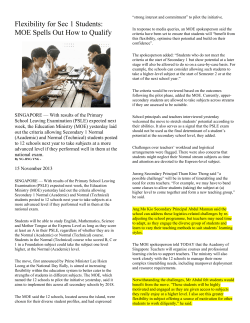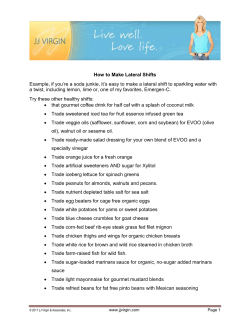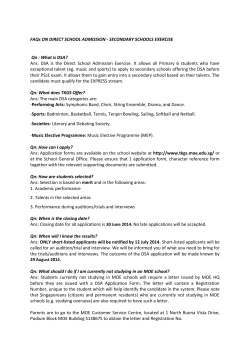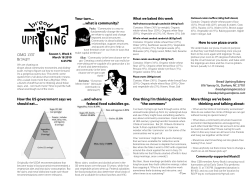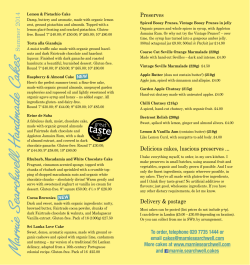
Document 257986
ORGANIC MATERIALS RECOVERY th October 31 , 2011 Re: Dundalk OMRC (Organic Materials Recovery Centre) Responses to questions and comments from the community Over the past few weeks, our company, the Mayor and Council of the Township of Southgate have received a number of questions and comments regarding the Organic Materials Recovery Centre Lystek International Inc. is planning to build and operate in the Eco Industrial Parkway, located in Dundalk, Ontario. This document is being made publicly available in response to these questions and comments, many of which are centered on our Certificate of Approval (C of A) submission to the Ministry of the Environment (MOE). It should be noted that Certificate of Approval (C of A) reports are not typically provided for public review. They are prepared in a style and format that the MOE reviewers request from consultants who are making submissions for MOE applications. However, in the spirit of being open and transparent, a decision was made to openly share these documents. Doing so spurred a number of additional questions and comments from the community and we are happy to respond. It is our sincere hope that this additional effort to educate and inform will be viewed positively. We also hope the information will be used in a fair and responsible manner. Lystek is a company founded by stewards of the environment for the purpose of creating a better world; a mandate that has and will remain true as we grow and prosper together with the people of Southgate. Each member of our staff has a track record of environmental responsibility. This is something we are all very proud of and will always preserve. We hope that the responses in this document help alleviate any remaining concerns the community may have. We also plan to form a Public Liaison Committee and will have representatives available shortly to meet with citizens personally to provide any further clarification that may be required while discussing the many benefits Lystek will bring to the community. Site Description Q1: In all of the Lystek MOE applications (appl for WDS, appl for Air), Lystek has described the site as "Approximately 1 km southeast of Dundalk, Ontario". This is a misleading statement as the site is less than 0.25 km from the Dundalk-Proton Community School property. A correct approximation of 0.25 km would be 0 km from Dundalk. Response: The center of Dundalk to the proposed site location was used as the approximate distance. The description in the report is provided to give the application reviewers a general idea of where the site is located. Note that there is a figure in the report that clearly shows the location of the proposed site and the town of Dundalk with all roads etc. The entire industrial subdivision is within the Town of Dundalk. Property Ownership Q2: In all of the Lystek MOE applications (appl for WDS, appl for Air), you state that Lystek is the owner and operating authority for the property. Lystek is not the current owners of the property, 1 ORGANIC MATERIALS RECOVERY there is a conditional sale agreement in place with several conditions that must be met before the sale can be finalized (including MOE approvals). The Township of Southgate is the current owner of the property. Also, Lystek states that "A 12.5 acre parcel in the Eco-Park has been purchased by Lystek" (D&O report, s. 2.1). In contrast, during the October 12th presentation to the public, Mr. Mosher was pointedly asked "Who owns the property?" Mr. Mosher answered "The Township owns the property." Response: To clarify, there is a binding offer between the Township of Southgate and Lystek International to purchase the property in question. Zoning Q3: There are several inaccuracies in Lystek's documents surrounding the issue of zoning. Lystek lists 2 adjacent land uses to the proposed site: Industrial, and Other - Leaf and yard waste composting (appl WDS, s. 3.3). In the section about zoning of the surrounding areas, the description only includes the zoning of the site, not of the surrounding area (D&O report, s. 2.2). Lystek has included diagrams of the 'land uses' by using the Southgate Official Plan designations rather than the actual zoning. Directly adjacent land includes A2 (Agricultural). Actual surrounding land uses include M1 (Industrial), A2 (Agricultural), CF (Community Facility - within 250 meters), and R2 (Residential - within 400 meters). Response: There is no discussion of adjacent properties in this section of the report. The subject property is zoned General Industrial M1. Prior to submission of the MOE application Lystek received a letter from the Township stating that “The property is properly zoned M1 with a permitted use as a waste processing facility and complies with the Southgate Official Plan”. This letter is appended to the MOE application document. Q4: Lystek states that "The site is located in a predominantly industrial zoned area" (Acoustic report, s. 6.6). The area includes M1 (Industrial), A2 (Agricultural), CF (Community Facility within 250 meters), and R2 (Residential - within 400 meters). Response: As noted in the previous response, the subject property is zoned General Industrial M1 and Lystek received a letter from the Township stating that “The property is properly zoned M1 with a permitted use as a waste processing facility and complies with the Southgate Official Plan”. Also note that the Township’s own wastewater facility is located within the Industrial Subdivision. Environmental Assessment Act (EAA) Q5: Lystek states that the works for this application are exempt from EAA under Section 2 of Ontario Regulation 345/93. (appl WDS, s. 5.1). What does 345/93 section 2 say? Why is this site exempt under that regulation? Response: The referenced section confirms that Lystek is exempt from an Environmental Assessment Act (EAA) because the amount of residual waste produced at the Lystek facility is well below the established waste volume threshold. 2 ORGANIC MATERIALS RECOVERY Public Consultation Q6: Lystek states that "Lystek will further summarize the results of these meetings and provide such summary to the MOE." (D&O report, s. 1.2). Where can this summary be seen? Response: This summary will be provided to the MOE as stated in our report and will also be provided to Township Council. Feedstock Q7) There is a lot of confusion about what the feedstock will be for the proposed plant. The list varies significantly from document to document. Response: The complete list of materials that we expect to process at the Lystek Dundalk Organic Material Recovery Centre, as identified in the C of A Application, are: • • • • • • dewatered and non-dewatered biosolids; digested solids from anaerobic digestion facilities servicing municipal and other organics streams including source separated organics; septage material; organic waste from the food processing industry and other industries that produce food wastes; organic waste from the commercial sector; and organic waste including, but not limited starches and paper wastes. We consolidated the above-noted list for the October 12, 2011 public meeting to simplify the presentation. An original copy of the C of A application was forwarded to the Township on August 8, 2011 - the same day it was sent to the MOE. Lystek has also provided an electronic copy to the Township. Q8) In pre-consultation with the MOE, Lystek was told they "must indicate all types and characteristics of wastes that will be received for processing in C of A" (Appendices WDS). Response: Lystek has complied with and will satisfy all requirements set out by the MOE to date and will continue to do so. Q9) Lystek states that "The Centre will be based on Lystek's proprietary organics processing technology and will process dewatered biosolids, liquid septage materials, and other similar organic materials from the agricultural and food processing sectors." (D&O report, s. 1.0). Later, you state that feedstock includes "Digested solids from anaerobic digestion facilities service municipal and other organic streams including source-separated organics" and "Organic sludges from the food processing industry and other industries that produce food wastes" (D&O report, s. 3.3). Please characterize what those materials are (give examples of each type, and indicate what is not acceptable). Response: Lystek will not accept organic waste material that does not meet applicable Federal and Provincial regulatory acceptance requirements. Any source of materials that Lystek will 3 ORGANIC MATERIALS RECOVERY consider must have satisfactory documentation of its characteristics and in all cases will be classified as non-hazardous materials under Ontario regulations. Q10) In the September presentation to the public, the list of feedstock sources included "Wastewater treatment plant biosolids", "Sewer lagoon biosolids", "Local agricultural manure", "Selected material from local septic storage systems", and "Other solid and liquid waste streams (abattoir, poultry waste)" (Sept presentation). In the October 12th presentation to the public, they included waste from "wastewater treatment plants", "private food industry", and "Residential septage haulers" (Oct 12 presentation). However, are abbatoir wash waters included, bodily fluids, etc? Response: Lystek has no intention to accept abbatoir wash waters. Q11) Lystek states "No hazardous material will be accepted at the Centre." (D&O report, s. 3.3). What is defined as hazardous material? Lystek does not define hazardous material. Response: Hazardous material is defined by the MOE in the Environmental Protection Act and can be reviewed at the link below: http://www.e-laws.gov.on.ca/html/regs/english/elaws_regs_900347_e.htm#BK24 Q12) Lystek states that "The Centre will receive feedstocks from the Province of Ontario." D&O report, s. 3.4). In contrast, in original discussions with the Township, Lystek stated that all feedstock would originate from within 100 km of Dundalk. Response: We expect that most of the feedstock material will originate from within an approximate 100 km radius of Dundalk. Travel time and at distances much beyond this radius starts to impose some practical and economic limitations. Q13) Lystek states that "1,000 tonnes of dewatered biosolids stored in the receiving hall, on emergency basis only. The intent is to clear the tipping floor of incoming dewatered biosolids on a daily basis, but variation in deliveries and processing necessitates short-term storage on occasion." (D&O report, s. 3.5). How short-term is 'short-term'? Response: A maximum of 5 days Q14) In regards to temporary storage of feedstock, Lystek states that "This area will provide area storage of dewatered solids, as required, if the tipping floor cannot be cleared at the end of each day of incoming materials." (D&O report, s. 4.4). Is it washed down each day? Where does the wash water go? Response: The floor in the area of the delivery hall will be washed down. Any wash water will be collected and used in the fertilizer process. 4 ORGANIC MATERIALS RECOVERY Odour Q15) Many residents of Dundalk are concerned about the odour from the trucks carrying the feedstock to the Lystek facility. In pre-consultation with the MOE, the notes indicate that "MOE's main concern is odour emissions" and "Odour emissions will come mostly from feedstock storage (cake pile) and incoming trucks." There is also a concern about the feedstock supply trucks as they come to the facility, as well as when they leave (the truck dumpster will have residue that will smell as well). Response: Lystek will implement all reasonable measures within our control to minimize potential for odour impact. These measures will include tarping of delivery vehicles, the use of sealed tanker vehicles and enforcement of a strict vehicle inspection and cleaning protocol. We also understand that Council will work diligently to implement the road by-pass that has been committed to by the Township. Q16) In addition, there is the concern of "queued" trucks, waiting to enter the facility. Lystek states that "There is provision for a full large transfer trailer to be queued prior to the weigh scale and additional queuing space is provided in the truck turning area identified on Figure 2.3." (D&O report, s. 4.2). The odour from these trucks is not handled by the biofilters that you are using for the inside-facility air. There is no specified wait time for these queued trucks. Odour from trucks passing by while travelling will be dispersed quickly as they are not stationary. Trucks waiting in this queue will result in concentrated odours wafting to the school property. How will you handle that? Is there a limit to the queue time? Response: The weigh scale has the ability to process approximately 50 trucks per hour. The facility has two doors. Under normal operating circumstances there will be very limited or no need for queuing of delivery vehicles. In the unlikely event that there is a weigh scale breakdown we will operate in manual processing mode. We do not foresee a need for queuing. Q17) Lystek states that "The exterior of trucks dumping in the tipping floor will be cleaned as required to remove debris" (D&O report, s 5.1). What about the interior of the truck bed (that's where the residue from the feedstock will be)? Response: Lystek will have a protocol in place for regular inspection, washing and cleaning of solid feedstock delivery vehicles. Q18) What about trucks delivering liquid feedstock to exterior FHT - will they be washed down too? Response: Lystek will have a protocol in place for regular inspection, washing and cleaning of liquid feedstock delivery vehicles. Q19) Where will the wash water go? Response: All wash water will be recycled in the fertilizer process. 5 ORGANIC MATERIALS RECOVERY Q20) Lystek states that "A 500 m3 feedstock holding tank (FHT) is provided between the main building and the storage lagoons. This FHT will receive liquid incoming product ..." (D&O report, s. 4.6). This is located outside. How is the odour managed if there is a spill? Response: Delivery will occur on a concrete pad which is sloped towards a collection catch-basin which conveys collected water to on-site underground storage tanks. There will be strict FHT delivery protocols in place. In the unlikely event of a spill the area will be immediately washed down and all wash water will be collected and recycled in the site fertilizer process. Q21) Lystek is depending on a ventilation system to deal with the odour of the 'cake pile' and delivery trucks. What happens if the ventilation system goes down? Response: The ventilation system has backup redundancy – there are actually three separate systems. We will have an electrical connection for a standby generator to keep the ventilation system operational in the event of power failure. Q22) What happens if electricity is out for days? Response: We will discontinue the delivery of incoming feedstock material if there is an extended power outage. We will have an electrical connection for a standby generator to keep the ventilation system operational. Q23) Lystek's odour source summary includes only odours originating inside the building (Acoustic report, Table 2). It does not include odours originating from the feedstock trucks waiting outside. Response: The trucks have very short transit time from the site entrance to the building and as such the delivery trucks in motion were not included as a point source in the odour modeling. Water and Wastewater Q24) There is some discrepancy in Lystek's documentation as to wastewater. Lystek states that "... the process is net water deficient, so no excess liquids are generated that require disposal or treatment." (D&O report, s. 3.1), then states that "In the unlikely event that excess process water is generated by the Centre, this will also be discharged to the sanitary sewer ..." (D&O report 4.11). There is a concern about the idea of the 'excess' being put in the Dundalk sewage system. Our sewage system is not equipped to handle the possible contaminants and pathogens that may come from other sources. Response: The initial process description is for operation of the facility under normal operating conditions. As a contingency measure the site should have a sanitary connection in place for excess process water. With respect to the concern over excess process water being discharged to the local sanitary sewer the referenced section of the report above goes on to say “pending confirmation that the quality of this liquid is within the sewer-use by-law specifications for the Township.” Note that this excess process water is mostly wash water from general cleanup in the delivery hall etc. 6 ORGANIC MATERIALS RECOVERY It should be noted that the sanitary connection would be primarily in place for the Lystek washroom and showering facilities. Q25) When it comes to water requirements for input into the process, it was my understanding that there would be no need for town water to feed the process. Yet, Lystek states "It is expected that the majority of process water requirements at the Centre will be satisfied by the incoming feedstocks, clean surface water taken from the on-site retention ditch, and clean surface water taken from the above final product lagoon storage covers. Potable water may be used if required." (D&O, s. 4.13). Response: The Lystek facility will require potable water for the washroom/shower facilities, the steam generator and some of the wash down operations of vehicles before they leave the facility. As part of our due diligence we had to confirm that there is available water and we will pay the Township for these uses. Truck Traffic Q26) Lystek's MOE application states "At design capacity, the number of trucks transporting organic materials to the Centre is expected to be a maximum on the order of 25 trucks/day ..." (D&O, s. 5.). In contrast, during the presentation to the public on October 12th, Lystek stated there would be "14 trucks per day feedstock" in 2016 - based on Certificate of Approval Limit (Oct 12 pres, slide 27). Response: Maximum 25. Average 14. Q27) There is a small discrepancy in the number of trucks moving the end product each day. Lystek's MOE application states "It is expected that a range of different vehicles will be used to haul the final fertilizer product, and that total numbers of outbound vehicles will be a maximum of 25 per day during the land application season." (D&O report, s. 5.5) whereas Lystek's presentation to the public on October 12, stated there would be "23 trucks per day fertilizer delivery" in 2016 - Certificate of Approval Limit (Oct 12 presentation, Slide 27). Response: Maximum 25. Certification Q28) Lystek states that "Once the Centre is operational, Lystek will apply for Canadian Food Inspect Agency certification of the processed final product as a Low Analysis Farm Fertilizer (LAFF)" (D&O report, s. 5.5). Then you state that the result of the process "is a pathogen free, high nutrient value Canadian Food Inspection Agency registered fertilizer product" (Oct 12 presentation, slide 11). Response: That is correct. Lystek will be applying to be certified as a LAFF in accordance with CFIA registration regulations. We use the term “high nutrient value” because the product is suitable to meet the fertilizer demand in lieu of the application of commercial chemical fertilizers. Q29) Lystek states that "Once the Centre is operational, Lystek will apply for Canadian Food Inspect Agency certification of the processed final product as a Low Analysis Farm Fertilizer (LAFF)." (D&O report, s. 5.5). 7 ORGANIC MATERIALS RECOVERY What happens to the product until you get the CFIA certification? Response: Until Canadian Food Inspection Agency (CFIA) registration is issued all fertilizer product will be applied in exactly the same manner pursuant to a Non Agricultural Source Materials (NASM) plan for approved farms. Once CFIA approval is granted a NASM plan is no longer required. Q30) How long does the certification take? Response: ASAP and expected by early 2013 in time for the spring fertilizer application season. Q31) Lystek states that "Lystek has achieved this certification for the final product produced by the City of Guelph's WWTP." (D&O report, s. 5.5). What about the St. Mary's plant? Has it been certified yet? Response: At this point the Town of St. Mary’s has elected not to pursue Canadian Food Inspection Agency (CFIA) registration because it has ample access to NASM approved farmland. CFIA registration has also been obtained for a site in the London area and will soon be obtained for another site in the Kingston area. Monitoring Q32) There is some concern over pathogens in the incoming feedstock, and the outgoing end product. Response: Based on validated, analytical data this concern is unfounded. This has been accepted by both Provincial and Federal agencies. Q33) Lystek states that "Incoming feedstock will be monitored on a weekly basis ...." (D&O report, s. 9.2). This does not guarantee that today's batch is acceptable. Each batch should be tested. Response: Incoming feedstock is tested regularly at the source as per applicable environmental requirements (link below). http://www.omafra.gov.on.ca/english/nm/nasm/wastewater.htm For additional redundancy Lystek will undertake supplementary Quality Assurance/Quality Control testing on incoming feedstock. Q34) Lystek states that "The final fertilizer product will be tested against CFIA analytical parameters, and will be monitored on a weekly basis ..." (D&O, s. 9.3). This does not guarantee that today's batch is acceptable. Each batch should be tested. Response: Outgoing fertilizer is stringently governed by a combination of four parties in addition to Lystek. These include CFIA, MOE, OMAFRA and our agricultural customers. We believe that our major customers in the area will be most familiar with OMFRA when it comes to meeting fertilizer application regulations. A link to the OMAFRA site is provided above. 8 ORGANIC MATERIALS RECOVERY Q35) Lystek states that "As the table shows, the final fertilizer product is below all regulatory limits and has no measurable pathogen content." (D&O report, s. 5.5). What pathogens are measured? What about ones that are not measured? Only a limited number of pathogens are tested for. You do not test for prions, nor does your process neutralize prions. Response: The finished fertilizer product will comply with regulated parameters as set out by Federal and Provincial agencies. Lystek intends to only accept materials from sources that have strict protocols in place for screening of a broad range of compounds, including prions. Processing Q36) Lystek states that during the "Warming phase - steam is injected into the reactor to heat the materials up to the desired temperature." (D&O report, s. 5.3). Where does the water come from for creating the steam? Response: The water used to create the steam will be provided by the Township of Southgate water supply system Lystek will pay the Township for any water used. Q37) Lystek states that "Processing time: the designed processing time for one batch of material is 30 to 60 minutes." (D&O report, s. 5.3). How long does it process once it gets up to temperature? Response: Approximately 30 minutes. Q38) Lystek states that it will "Clean up and appropriately dispose of any spilled material". (D&O report, s. 10.2). What does appropriate disposal mean? Response: In accordance with applicable regulations. End Product Q39) Lystek states that the end product is "stable for winter storage (freeze =thaw stable)" (D&O report, s. 3.1). Is there any separation of product while stored (e.g., solids or thicker liquid at the bottom)? Response: No. Q40) Lystek states that "For final delivery of the product, a pump station will draw liquid from the lagoons into a holding tank, from where it can be directly pumped at a faster rate into outbound vehicles at the loading station." (D&O report, s. 5.4). What if the liquid separates? Response: There is no separation in the final Lystek fertilizer product. Q41) Where is this tank located? Response: Adjacent to the building. 9 ORGANIC MATERIALS RECOVERY Q42) How is the odour managed if there is a spill? Response: Immediate clean up and wash down of area. Collection and recycling of wash water. Q43) Lystek states that "Lystek final fertilizer product (typical NPK ratio 3:3:4) can meet all of these fertilizer demands without any practical limitation to annual application rates to land." (D&O report, s. 5.5). Is its application regulated by a nutrient management plan? Response: Yes, NASM until CFIA registration. Q44) Lystek plans to use "Covered and lined final fertilizer product storage lagoons" (D&O report, s. 4.1). Are the liners sealed, or is the cover floating (detachable from liner)? Response: The liner is properly anchored and the cover is sealed and attached. Q45) Lystek states that "If storage capacity for the final product in the on-site lagoons is exceeded, additional portable storage in the form of sealed containers will be brought to the Centre on a temporary basis." (D&O report, s. 10.3). I don't think it should allow temporary storage. Incoming deliveries should be discontinued. Response: This is a safety measure that would only be implemented on a short term contingency basis. Operating Hours Q46) Lystek states that "The Centre receives feedstock materials between 6 a.m. and 6 p.m. Monday to Saturday and processes material 24 hours a day, 365 days a year." (Acoustic report, s. 1.5). Elsewhere, they state that it is a "5.5 day work week" (Oct 12 presentation, slide 26). Response: For the purposes of the C of A we are required to use a 24 hour working period to maintain air handling and other equipment. The 5.5 day work week is in reference to actual material receiving operations. We intend to only be receiving trucks during this 5.5 day work week. Noise Q47) Lystek identifies the second closest point of reception (POR2) as the Kids 'n Us daycare. The distance is measured to the building, not to the school yard that the public school children play in. Is this not a 'point of reception'? Response: The noise modeling was based on the assumption that the children at the daycare would be indoors the majority of time. The MOE will evaluate this assumption as part of their review process. Just to give some perspective on this issue: the requirements for this analysis are noise levels of 40-45 dBA. For example, a refrigerator or typical farm has as a noise level of approximately 4045 dBA. Reference: http://www.engineeringtoolbox.com/sound-power-level-d_58.html 10 ORGANIC MATERIALS RECOVERY Q48) Lystek's Point of Reception Noise Impact (Table 2) indicates different distances from different types of trucks to the point of reception. All the trucks take the same truck route, and potentially could use the truck turning area, so why do the distances differ by as much as 26 meters? Response: At the time of noise modeling our consultant did not have access to the drawing, which included the turning circle, and therefore assumed the loading points would be the noise sources. However this distance would represent a very small change in the sound levels (and only at the daycare, given the geometry). Therefore it does not result in a concern given that we are well under the required sound level of 40 dBA (33.9 dBA at the Day Care Centre). Q49) Lystek indicates that the application does not meet the minimum separation distance from the closest POR (appl Air, question 11). This is a concern. Response: We did not meet this minimum separation distance of 400m and were therefore required to complete an AAR (Acoustic Assessment Report). The AAR then checks to see if our facility will comply with the requirements of the MOE. According to the AAR report we comply with these requirements (i.e. noise levels less than 40 dBA at all times). Q50) Lystek stated that 'Adjustments for Elevated Background Noise at Point of Reception" includes "POR within 30 m or a Provincial Highway or Arterial Road" (Noise Screening Process for S.9 Applications - Supplement to Application for Approval, question 3). There is no 'arterial' road close to either POR, not as far as I understand an 'arterial' road. The residence (POR1) is on a township secondary road (Ida Street/2nd Line SW), and the school and daycare (POR2) is on a dead-end street (Young St and Hagen St), in a residential neighbourhood. Response: As noted above, we were required to complete an AAR to ensure this was addressed. 11
© Copyright 2025
